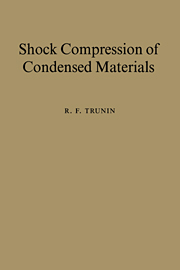5 - Minerals
Published online by Cambridge University Press: 03 December 2009
Summary
Certainly, it is impossible to measure the compressibility of all natural minerals, especially as pure chemical compounds are in a minority among them, and most natural minerals are composite structures, which makes their total number much larger. Therefore we studied the most typical species of various groups of minerals and generalized our results as far as possible.
Let us recall that inorganic minerals are usually classified into four groups in terms of chemical bonds between their structural units. These are oxides, oxysalts, halides, and native elements (this group includes metals discussed in the previous section). The first three groups are subdivided into smaller subclasses, but we shall consider the compressibility of representatives of large groups only.
Oxides
Silicon dioxide
Of all oxide compounds whose shock compression has been measured, quartz (or, more precisely, various modifications of SiO2) is the best studied material as concerns both the range of applied pressure, of initial states and phases, and the diversity of effects produced by shock in samples. The shock compression of α-quartz or its polycrystalline phase quartzite, coesite (one of the high-density phases of silicon dioxide), crystoballite (a less dense phase), and amorphous quartz was studied at different times for different purposes. Porous Hugoniots, double-compression Hugo- niots, and expansion Hugoniots of SiO2 have been measured. In fact, this is the only oxide whose compression was measured not only in laboratory, but also in full-scale experiments. In the latter measurements, the pressure was up to 2 TPa, i.e., nearly an order of magnitude higher than in laboratory experiments performed with such materials.
- Type
- Chapter
- Information
- Shock Compression of Condensed Materials , pp. 106 - 129Publisher: Cambridge University PressPrint publication year: 1998



